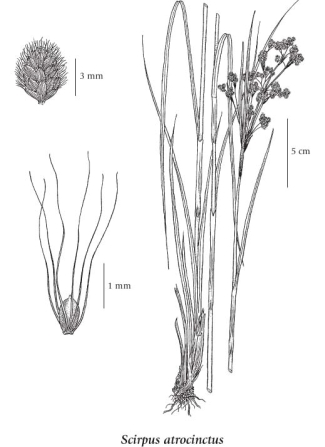wool-grass (blackgirdle bulrush)
Cyperaceae (Sedge family)
Introduction to Vascular Plants
Introduction
Woolgrass is a native species of sedge in North America that is considered invasive and exotic in British Columbia (BC Conservation Data Center 2010, Reznicek pers. com. 2010). In North America, it is found from BC to Newfoundland, south to Florida and Texas (BC Conservation Data Center 2010). In BC, it is reported from the Greater Vancouver area, Harrison Lake area, Pitt Polder, Eagle River, Duncan, Saturna Island, Kamloops, Revelstoke, Creston (Lomer pers. com. 2010), where it is found in a variety of wetland types, including marshes, meadows, ditches, pond edges, and bogs. The first record for this species in BC was from Matsqui in the Fraser Valley in 1938, when it was collected by W. Jones.
Woolgrass is a tall, distinctive sedge species with drooping, woolly-looking inflorescences. It is a tussock-forming species with a short, branched rhizome (Flora North America 2010). It is part of the Scirpus cyperinus complex that is considered taxonomically challenging (Reznicek 2009). It is a morphologically variable species. Reznicek (pers. com. 2010) says it is particularly variable "from a north/south perspective...southern plants are much larger and with more branched inflorescences". It is reported to hybridize with other species of Scirpus (e.g. S. atrocinctus), forming hybrid swarms (Flora North America 2010). A complete description of the species is provided in Flora North America. Listen to sedge expert Tony Reznicek (University of Michigan) talking about the Scirpus cyperinus complex, and identification difficulties in this group. |
Species Information
General:
Perennial, tufted herb from fibrous roots; stems nearly circular in cross-section, tapered, 80-150 cm tall.
Leaves:
Several, both stem and basal; blades elongate, flat, grass-like, 2-6 mm wide.
Flowers:
Spikes numerous, terminal, 3-8 mm long, egg-shaped to cylindrical, shortly slender-stalked in compound, terminal, sometimes condensed clusters, the branches ascending from the base, more or less spreading above, the ultimate branchlets also with one to several, unstalked spikes; involucral bracts several, conspicuous, leaflike, unequal, sheathless, blackish at the base, spreading, usually drooping at the tips, the largest rarely less than 10 cm long.
Fruits:
Scales numerous, pale to often blackish or blackish-green with fine, red-brown parallel lines, about 1.5 mm long, smooth, egg-shaped, short awn-tipped to blunt; perianth bristles 6, well-developed, slender, flexuous, tawny, much surpassing the scales and achenes (especially in fruit, then the spike appearing short-woolly); stigmas 3; achenes compressed, 3-angled, pale, yellowish-grey to nearly white, 0.7-1 mm long, abruptly sharp-pointed.
Illustration

If more than one illustration is available for a species (e.g., separate illustrations were provided for two subspecies) then links to the separate images will be provided below. Note that individual subspecies or varietal illustrations are not always available.
Illustration Source: The Illustrated Flora of British Columbia
Ecology
The table below shows the species-specific information calculated from
original data (BEC database) provided by the BC Ministry of Forests and Range.
(Updated August, 2013)
| Site Information |
Value / Class |
||
|
Avg |
Min |
Max |
|
| Elevation
(metres) |
717 | 350 | 945 |
| Slope
Gradient (%) |
3 | 0 | 24 |
|
Aspect (degrees) |
205 | 87 | 328 |
| Soil
Moisture Regime (SMR) [0 - very xeric; 4 - mesic; 8 - hydric] |
5 | 4 | 8 |
| Modal
Nutrient Regime
Class |
C | ||
| #
of field plots species was recorded in: |
26 | ||
| Modal
BEC Zone Class |
SBS | ||
|
All BEC Zones (# of stations/zone) species was recorded in |
ICH(5), SBS(21) | ||
|
Source:
Klinkenberg 2013
|
|||
Habitat and Range
Swamps and wet meadows in the lowland and montane zones; frequent in extreme SW BC, infrequent in SC BC, rare in SE and NE BC and the Queen Charlotte Islands; E to NF and S to ME, MA, PA, WV, MI, IL, IA, SD and WY.Status Information
Synonyms
Synonyms and Alternate Names:
Scirpus cyperinus var. brachypodus (Fernald) Gilly